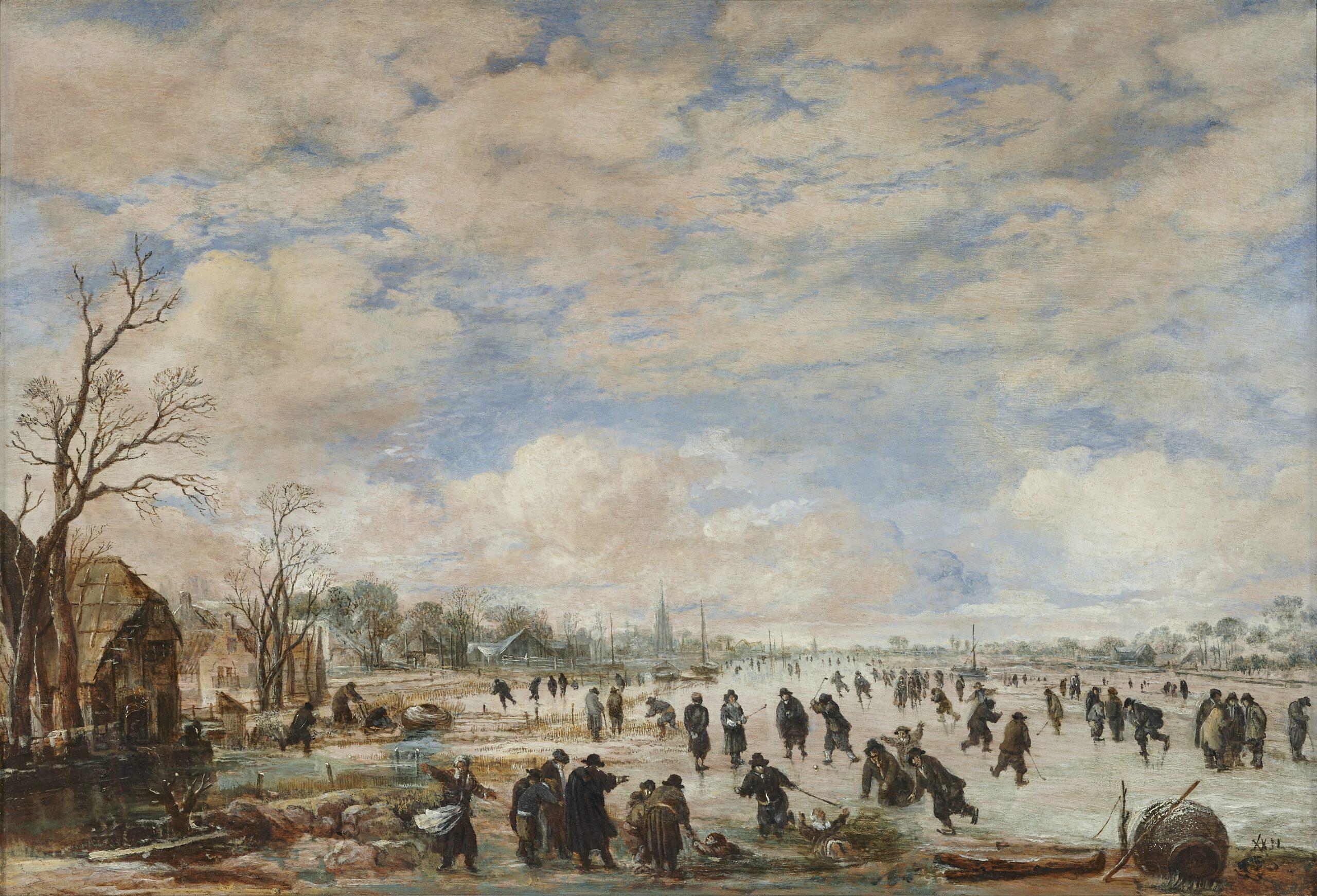Gorinchem 1604 – Amsterdam 1677
Skaters and Kolf Players on a frozen Waterway
Signed with monogram ‘AV DN ’ | Lower right
Oil on panel
H. 33,6 cm. | W 49 cm.
PROVENANCE
Collection Arnoud van den Lennep;
His deceased sale | Amsterdam | 24 July 1792 | Lot 67 (30 fl. To van der Schley);
Collection of Henry 3rd Marquess of Lansdowne (1780-1863) | Bowood House | Thence by descent to:
Collection of Henry 6th Marquess of Lansdowne (1872-1936) | By descent to:
Private collection Lady Nairne | London;
With Agnew | London | by 1991;
Anonymous sale | Christie’s | London | 8 December 1995 | Lot 21 as ‘collection of a Noblewoman’ (est. £ 200.000-300.000) | Withdrawn;
With Johnny van Haetfen Ltd. | London | by 2013 (ref. VP4609) | where acquired by:
Private collection | The Netherlands
LITERATURE
Ambrose, G.E. (1897). Catalogue of the Collection of Pictures Belonging to the Marques of Lansdowne, K.G., at Lansdowne House, London and Bowood, Wiltshire. London, pp.70-71, nr. 107;
Hofstede de Groot, C. (1923). A catalogue raisonné of the works of the most eminent Dutch painters of the seventeenth century. London, Vol VII, p. 411, nr. 489 and p. 454, nr. 547 (‘Bright and masterly in style’);
Schulz, W. (2002). Aert van der Neer. Doornspijk: Davaco, p. 188, nr. 223 (as whereabouts unknown)
EXPERTISE
With certificate, dd. Berlin 13 April 2013, by Prof. dr. Wolfgang Schulz, after first hand inspection of the original
EXHIBITION
On loan to the National Gallery, Scotland, 1996 – 2012;
The Art of Golf, The High Museum of Art, Atlanta, Georgia (February – June 2012), The Oklahoma City Museum of Arts (July – October 2012), Museum of Fine Arts, St Petersburg, Florida (November 2012 – February 2013)
RECORD
The present painting is recorded at the RKD, The Hague, under nr. 6401
CATALOGUE NOTE
Dated by Schulz in the second half of the 1660s (see ‘Certificate’ dd. Berlin 13 April 2013), the present picture is arguably amongst the best works within the mature winter landscapes by Van de Neer. The artist was already in his thirties when he began to include winter scenes in his repertoire, no doubt in response to the growing popularity of the theme and to compete with the increasing number of artists who addressed it. In the present work Van de Neer chose relatively low horizon, giving greater emphasis to the atmospheric rendering of a bright blustery sky. The present work is an excellent example of Van der Neer’s mature winter scenes that adopt an increasingly limited, earthen palette in keeping with the monochrome tradition.
In his extensive catalogue raisonné on leading masters from the Golden Age, London 1923, Hofstede de Groot lauds the present picture as ‘bright and masterly in style’. Schulz saw this picture in 1984 when it was in the collection of Lady Nairne, London, in a heavy overpainted condition. In his catalogue raisonné, Doornspijk 2002, he lists it as being in ‘poor condition’. However, in his letter and subsequent expertise after first hand inspection of the original in 2013, Schulz found the picture – happily surprised – to be in such a good condition. Therefore if seams plausible to assume that extensive retortion was conducted at some point between the 1920s and 1980s. Be that as it may, the present picture is an important addition to Van der Neer’s late mature period. The farm on the left also occurs in reverse on the right side of another landscape by Van der Neer (Schulz, 2002, p. 187, cat. nr. 215).
Winter scenes were a particularly popular theme for Dutch painters of the seventeenth century and found their roots in the earlier winter landscapes of Flemish artists like Pieter Bruegel the Elder. Such paintings allowed artists like Esaias van de Velde, Hendrick Avercamp and Aert van der Neer to indulge themselves in the depiction of a broad spectrum of society engaged in leisure activities. Van der Neer’s acute observation is evident here not only in the myriad of figures who skate, stride and slide across the frigid landscape, but also of the children falling into a hole in the ice in the foreground. Notable as well are the pair of figures in the foreground who engage in a game of kolf, a predecessor of the modern game of golf. Kolf originated in the Middle Ages and involved the use of a club to knock a ball towards a target. The sport grew so popular in the urbanised Dutch environment and its players so rowdy from too much drink that the resulting damage to personal property induced a number of city councils to pass laws restricting its play to the countryside.

